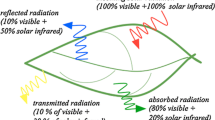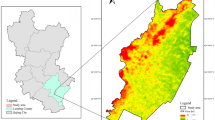Abstract
Trees form a significant part of the urban vegetation. Their meteorological and climatological effects at all scales in urban environments make them a flexible tool for creating a landscape oriented to the needs of an urban dweller. This study aims at quantifying the spatio-temporal patterns of canopy temperature (T C) and canopy-to-air temperature difference (∆T C) in relation to meteorological conditions and tree-specific (physiological) and urban site-specific characteristics. We observed T C and ∆T C of 67 urban trees (18 species) using a high-resolution thermal-infrared (TIR) camera and meteorological measurements in the city of Berlin, Germany. TIR images were recorded at 1-min intervals over a period of 2 months from 1st July to 31st August 2010. The results showed that ∆T C depends on tree species, leaf size and fraction of impervious surfaces. Average canopy temperature was nearly equal to air temperature. Species-specific maximum ∆T C varied between 1.9 ± 0.3 K (Populus nigra), 2.9 ± 0.3 K (Quercus robur), 3.2 ± 0.5 K (Fagus sylvatica), 3.9 ± 1.0 K (Platanus acerifolia), 4.6 ± 0.2 K (Acer pseudoplatanus), 5.0 ± 0.5 K (A. platanoides) and 5.6 ± 1.1 K (A. campestre). We analysed ∆T C for a hot and dry period (A) and a warm and wet period (B). The range of species-specific ∆T C at noon was nearly equal, i.e. 4.4 K for period A and 4.2 K for period B. Trees surrounded by high fraction of impervious surfaces showed consistently higher ∆T C. Knowledge of species-specific canopy temperature and the impacts of urban structures are essential in order to optimise the benefits from trees in cities. However, comprehensive evaluation and optimisation should take the full range of climatological effects into account.








Similar content being viewed by others
References
Akbari H, Pomerantz M, Taha H (2001) Cool surfaces and shade trees to reduce energy use and improve air quality in urban areas. Sol Energy 70:295–310
Benjamin M, Winer A (1998) Estimating the ozone-forming potential of urban trees and shrubs. Atmos Environ 32:53–68
Bowler DE, Buyung-Ali L, Knight TM, Pullin AS (2010) Urban greening to cool towns and cities: a systematic review of the empirical evidence. Landscape Urban Plan 97:147–155
Brown R, Gillespie T (1990) Estimating radiation received by a person under different species of shade trees. J Arboric 16:158–161
Campbell GS, Norman JM (1998) An introduction to environmental biophysics. Springer, New York
Celestian SB, Martin CA (2005) Effects of parking lot location on size and physiology of four southwest landscape trees. J Arboric 31:191–197
Chmielewski FM, Köhn W (1999) The long-term agrometeorological field experiment at Berlin-Dahlem, Germany. Agric For Meteorol 96:39–48
Christen A, Meier F, Scherer D (2011) High-frequency fluctuations of surface temperatures in an urban environment. Theor Appl Climatol. doi:10.1007/s00704-011-0521-x
Elias P (1979) Leaf diffusion resistance pattern in an Oak-Hornbean forest. Biol Plantarum 21:1–8
Fortunati A, Barta C, Brilli F, Centritto M, Zimmer I, Schnitzler JP, Loreto F (2008) Isoprene emission is not temperature-dependent during and after severe drought-stress: a physiological and biochemical analysis. Plant J 55:687–697
Foster JR (1992) Photosynthesis and water relations of the floodplain tree, boxelder (Acer negundo L.). Tree Physiol 11:199–149
Fuchs M (1990) Infrared measurement of canopy temperature and detection of plant water stress. Theor Appl Climatol 42:253–261
Gastellu-Etchegorry J (2008) 3D modeling of satellite spectral images, radiation budget and energy budget of urban landscapes. Meteorol Atmos Phys 102:187–207
Grace J (1978) The turbulent boundary layer over a flapping Populus leaf. Plant Cell Environ 1:35–38
Grimmond CSB, Souch C, Hubble MD (1996) Influence of tree cover on summertime surface energy balance fluxes, San Gabriel Valley, Los Angeles. Clim Res 6:45–57
Gromke C, Ruck B (2007) Influence of trees on the dispersion of pollutants in an urban street canyon—experimental investigation of the flow and concentration field. Atmos Environ 41:3387–3302
Gulyás Á, Unger J, Matzarakis A (2006) Assessment of the microclimatic and human comfort conditions in a complex urban environment: modelling and measurements. Build Environ 41:1713–1722
Hagishima A, Narita K, Tanimoto J (2007) Field experiment on transpiration from isolated urban plants. Hydrol Processes 21:1217–1222
Handa IT, Körner C, Hattenschwiler S (2005) A test of the tree-line carbon limitation hypothesis by in situ CO2 enrichment and defoliation. Ecology 86:1288–1300
Heilman JL, Brittin CL, Zajicek JM (1989) Water-use by shrubs as affected by energy exchange with building walls. Agric For Meteorol 48:345–357
Heisler GM (1986) Effects of individual trees on the solar radiation climate of small buildings. Urban Ecol 9:337–359
Hoyano A (1988) Climatological uses of plants for solar control and the effects on the thermal environment of a building. Energy Build 11:181–199
Hoyano A, Asano K, Kanamaru T (1999) Analysis of the sensible heat flux from the exterior surface of buildings using time sequential thermography. Atmos Environ 33:3941–3951
Jones HG (1992) Plants and microclimate. Cambridge University Press, Cambridge
Kesselmeier J, Staudt M (1999) Biogenic volatile organic compounds (VOC): an overview on emission, physiology and ecology. J Atmos Chem 33:23–88
Kjelgren R, Montague T (1998) Urban tree transpiration over turf and asphalt surfaces. Atmos Environ 32:35–41
Körner C, Scheel JA, Bauer H (1979) Maximum leaf diffusive conductance in vascular plants. Photosynthetica 13:45–82
Lagouarde JP, Ballans H, Moreau P, Guyon D, Coraboeuf D (2000) Experimental study of brightness surface temperature angular variations of maritime pine (Pinus pinaster) stands. Remote Sens Environ 72:17–34
Lebourgeois F, Levy G, Aussenac G, Clerc B, Willm F (1998) Influence of soil drying on leaf water potential, photosynthesis, stomatal conductance and growth in two black pine varieties. Ann Sci Forest 55:287–299
Leuzinger S, Körner C (2007) Tree species diversity affects canopy leaf temperatures in a mature temperate forest. Agric For Meteorol 146:29–37
Leuzinger S, Vogt R, Körner C (2010) Tree surface temperature in an urban environment. Agric For Meteorol 150:56–62
Lindberg F, Grimmond C (2011) The influence of vegetation and building morphology on shadow patterns and mean radiant temperatures in urban areas: model development and evaluation. Theor Appl Climatol 105:311–323
Litschke T, Kuttler W (2008) On the reduction of urban particle concentration by vegetation—a review. Meteorol Z 17:229–240
Lusk CH, Wright I, Reich PB (2003) Photosynthetic differences contribute to competitive advantage of evergreen angiosperm trees over evergreen conifers in productive habitats. New Phytol 160:329–336
Mayer H, Höppe P (1987) Thermal comfort of man in different urban environments. Theor Appl Climatol 38:43–49
Meier F, Scherer D, Richters J (2010) Determination of persistence effects in spatio-temporal patterns of upward long-wave radiation flux density from an urban courtyard by means of Time-Sequential Thermography. Remote Sens Environ 114:21–34
Meier F, Scherer D, Richters J, Christen A (2011) Atmospheric correction of thermal-infrared imagery of the 3-D urban environment acquired in oblique viewing geometry. Atmos Meas Tech 4:909–922. doi:10.5194/amt-4-909-2011
Montague T, Kjelgren R (2004) Energy balance of six common landscape surfaces and the influence of surface properties on gas exchange of four containerized tree species. Sci Hortic 100:229–249
Morecroft MD, Roberts JM (1999) Photosynthesis and stomatal conductance of mature canopy Oak (Quercus robur) and Sycamore (Acer pseudoplatanus) trees throughout the growing season. Funct Ecol 13:332–342
Mueller EC, Day TA (2005) The effect of urban ground cover on microclimate, growth and leaf gas exchange of oleander in Phoenix, Arizona. Int J Biometeorol 49:244–255
Oke T (1979) Advectively-assisted evapotranspiration from irrigated urban vegetation. Bound-Lay Meteorol 17:167–173
Oke TR (1989) The micrometeorology of the urban forest. Philos Trans R Soc London, Ser B 324:335–349
Potchter O, Cohen P, Bitan A (2006) Climatic behavior of various urban parks during hot and humid summer in the Mediterranean city of Tel Aviv, Israel. Int J Climatol 26:1695–1711
Robitu M, Musy M, Inard C, Groleau D (2006) Modeling the influence of vegetation and water pond on urban microclimate. Sol Energy 80:435–447
Rosenfeld AH, Akbari H, Bretz S, Fishman BL, Kurn DM, Sailor D, Taha H (1995) Mitigation of urban heat islands—materials, utility programs, updates. Energy Build 22:255–265
Running SW (1976) Environmental control of leaf water conductance in conifers. Can J Forest Res 6:104–112
Sandford AP, Jarvis PG (1986) Stomatal responses to humidity in selected conifers. Tree Physiol 2:89–103
Schuepp PH (1993) Tansley review No. 59. Leaf boundary-layers. New Phytol 125:477–507
Senate Department for Urban Development (2007) Berlin digital environmental atlas 01.02 impervious soil coverage (sealing of soil surface). Database: Urban and Environmental Information System (UEIS). http://www.stadtentwicklung.berlin.de/umwelt/umweltatlas/e_text/ekb102.pdf. Accessed 21 Mar 2012
Shashua-Bar L, Hoffman ME (2000) Vegetation as a climatic component in the design of an urban street—an empirical model for predicting the cooling effect of urban green areas with trees. Energy Build 31:221–235
Shashua-Bar L, Pearlmutter D, Erell E (2009) The cooling efficiency of urban landscape strategies in a hot dry climate. Landscape Urban Plan 92:179–186
Souch CA, Souch C (1993) The effect of trees on summertime below canopy urban climates: a case study. Bloomington, Indiana. J Arboric 19:303–312
Spronken-Smith RA, Oke TR (1998) The thermal regime of urban parks in two cities with different summer climates. Int J Remote Sens 19:2085–2104
Streiling S, Matzarakis A (2003) Influence of single and small clusters of trees on the bioclimate of a city: a case study. J Aboric 29:309–316
Thorsson S, Lindqvist M, Lindqvist S (2004) Thermal bioclimatic conditions and patterns of behaviour in an urban park in Göteborg, Sweden. Int J Biometeorol 48:149–156
Upmanis H, Eliasson I, Lindqvist S (1998) The influence of green areas on nocturnal temperatures in a high latitude city (Göteborg, Sweden). Int J Climatol 18:681–700
Vogel S (2009) Leaves in the lowest and highest winds: temperature, force and shape. New Phytol 183:13–26
Voogt JA, Oke TR (1997) Complete urban surface temperatures. J Appl Meteorol 36:1117–1132
Voogt JA, Oke TR (2003) Thermal remote sensing of urban climates. Remote Sens Environ 86:370–384
Whitlow TH, Bassuk NL, Reichert DL (1992) A 3-year study of water relations of urban street trees. J Appl Ecol 29:436–450
Acknowledgments
We would like to thank Petra Grasse (Institute of Meteorology, Freie Universität Berlin) for providing the cloud data and Jörn Welsch (Urban and Environmental Information System, Senate Department for Urban Development) for providing the impervious soil coverage map for Berlin. Especially we would like to thank Albert Polze, Britta Jänicke and Marco Otto for assistance in tree data collection and analysis.
Author information
Authors and Affiliations
Corresponding author
Rights and permissions
About this article
Cite this article
Meier, F., Scherer, D. Spatial and temporal variability of urban tree canopy temperature during summer 2010 in Berlin, Germany. Theor Appl Climatol 110, 373–384 (2012). https://doi.org/10.1007/s00704-012-0631-0
Received:
Accepted:
Published:
Issue Date:
DOI: https://doi.org/10.1007/s00704-012-0631-0




